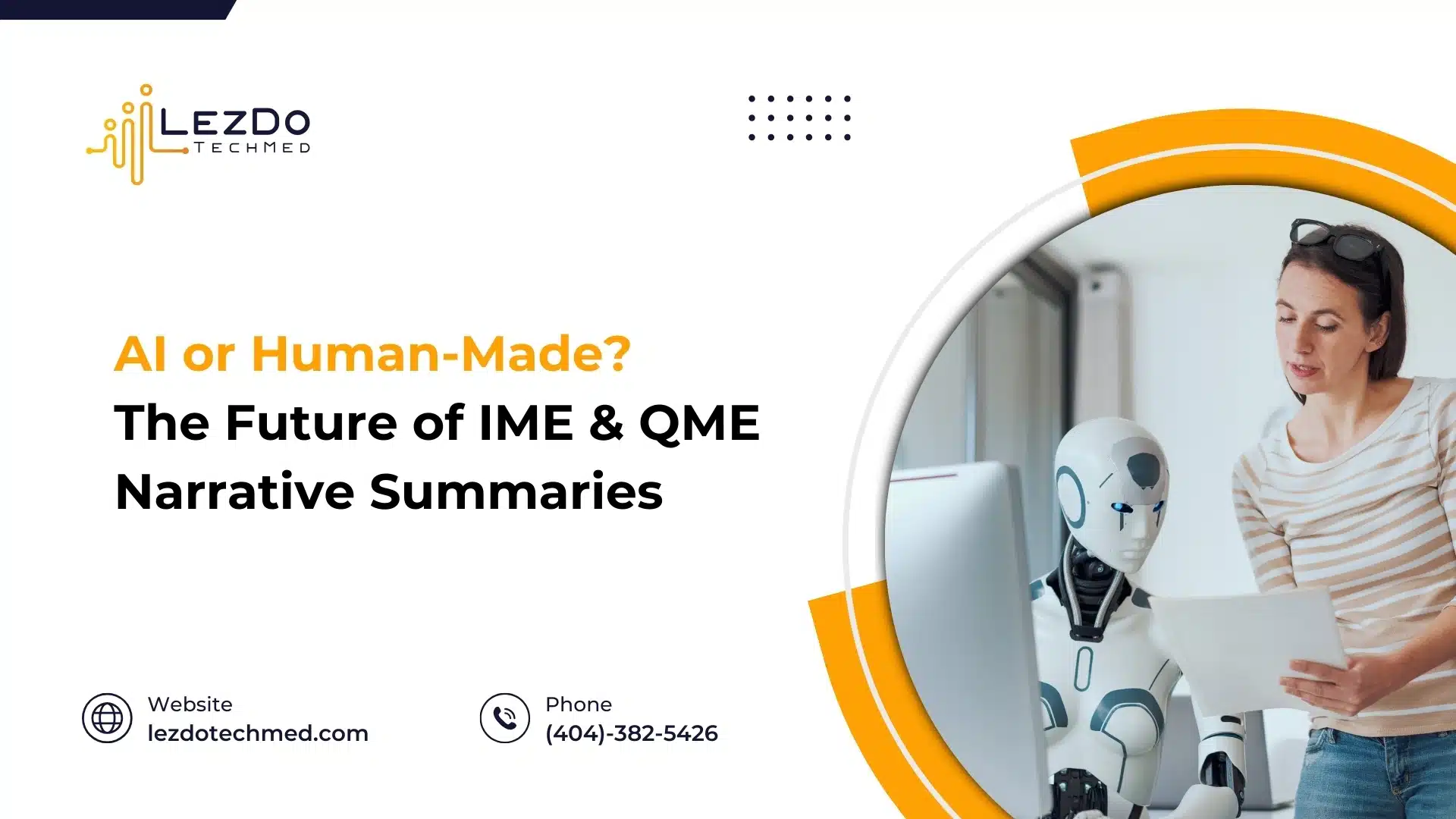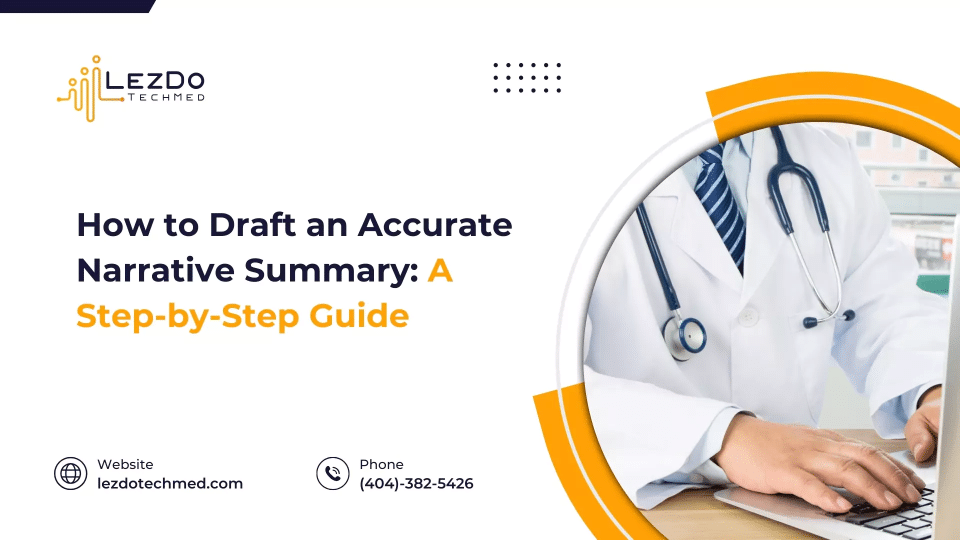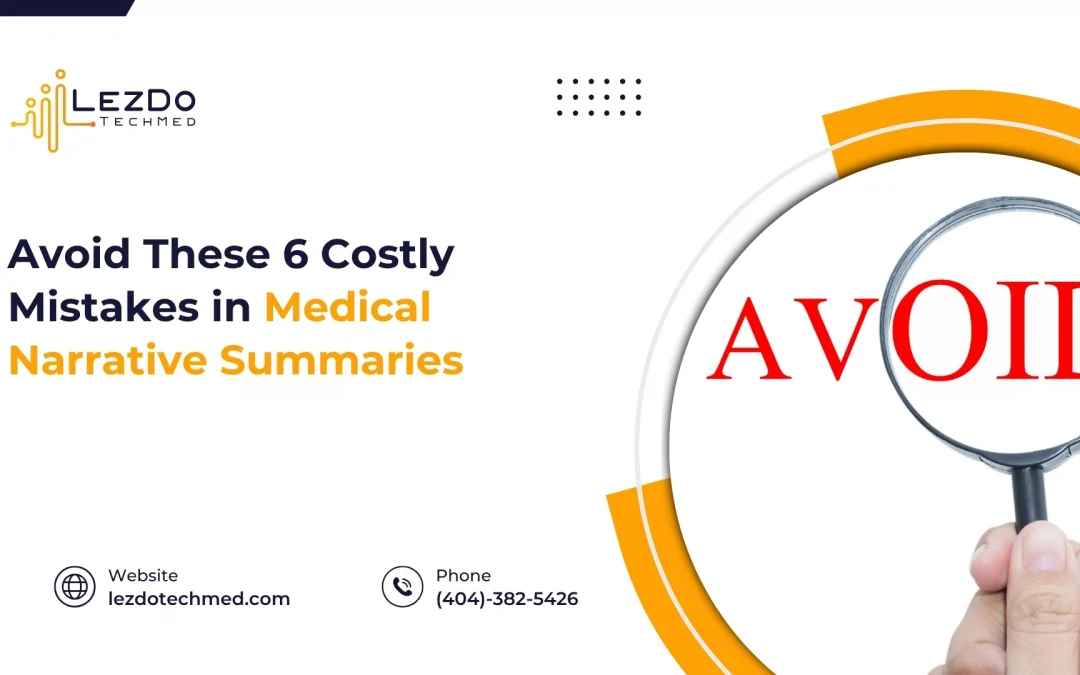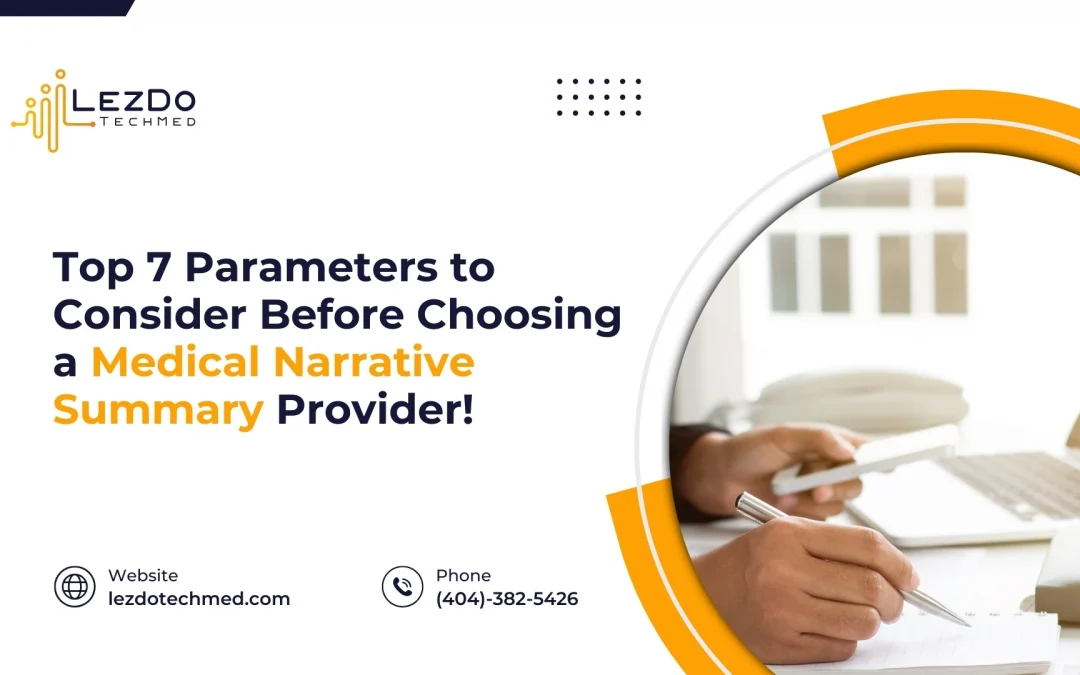Every industry has embraced Artificial Intelligence in their processes, and medical evaluation is no exception. Many Independent Medical Examiners (IMEs) and Qualified Medical Evaluators (QMEs) utilize the abilities of AI to speed up their evaluation process. AI resolves their major challenge in analyzing volumes of complex medical records, including progress notes, imaging studies, surgical reports, and treatment histories.
AI can create narrative summaries to ease the evaluation processes. It transforms scattered documents into a concise, chronological, and meaningful narrative of a patient’s medical journey, helping evaluators focus on what truly matters.
However, some questions prevail in the minds of the evaluators:
- Should these summaries be crafted by humans, powered by AI, or a mix of both?
- Will AI be accurate in producing narrative summaries?
- Will it miss key facts impacting my medical opinions?
If you are you an IME or a QME, you may have similar questions racking your mind. Come, let’s explore and analyze the future of IME & QME narrative summaries.
Qualities of a Good Narrative Summary
Let’s try to understand how your medical narrative summaries should be:
- Comprehensive picture: The summary should present the patient’s medical journey from injury or illness onset and treatment to the present status.
- Present key medical evidence: It should highlight vital evidence from imaging, diagnostic reports, physician notes, and functional limitations.
- Remove redundancy: Eliminating duplicate records and irrelevant details clears the clutter and makes the document precise and accurate, tight-packed with facts.
- Fact-oriented: Summary should present an objective presentation of medical facts from records and not the opinions of the reviewer.
- Legally defensible: It should help you form opinions that withstand scrutiny in court.
Human-Made IME & QME Narrative Summaries
Traditionally, human record reviewers, such as legal nurse consultants or medical-legal experts, manually went through every page of the medical records and created narrative summaries. They extracted relevant medical details, organized them chronologically, and presented them in an easy-to-read format, helping with your evaluations.
Benefits of Human-Made Narrative Summaries
- Clinical understanding: With their experience and expertise, human reviewers can spot nuances in physician notes, differentiate between relevant and irrelevant information, and understand context in a way machines sometimes miss. They can simplify the specialty and physician-specific medical jargon for you.
- Legal relevance: Reviewers can relate aspects like causation, disability, or impairment, that are particularly relevant for IMEs and QMEs in the legal context.
- Customization: Every case is unique. Human-prepared summaries can be tailored to your evaluation preferences or the case’s requirements.
- Critical thinking: Humans can identify contradictions in records, highlight gaps in care, or flag inconsistencies that might influence the case’s outcome. This can help you identify the issues and give evidence-based opinions.
Limitations of Manual Summaries
- Time-Consuming: Reviewing thousands of pages takes hours or even days. This can risk you in meeting report deadlines.
- Costly: Skilled medical reviewers are expensive to hire. Administrative expenses for maintaining an in-house team of reviewers may drain your pockets.
- Prone to errors: Humans can miss details after reviewing lengthy, repetitive notes due to exhaustion. Even a minor error can impact your informed decisions, leaving your reputation at risk.
- Scalability Issues: For evaluators handling larger caseloads, purely manual summaries may slow down turnaround times. This can prevent you from accepting more cases and growing your practice.
The Introduction of AI-Powered Narrative Summaries
With the advent of AI and Natural Language Processing (NLP), analysis of voluminous medical records has become stress-free and less time-consuming. These technologies can quickly scan records, extract diagnoses, treatments, medications, and test results, and generate a structured narrative report.
Strengths of AI Summaries
- Speed: AI can process thousands of pages in minutes, reducing the time to delivery. This can help you schedule evaluations and meet report deadlines without stress.
- Consistency: Algorithms don’t get tired or distracted, and they follow rules consistently. With precise prompts, you do not miss any vital details that can be crucial in forming your medical opinions.
- Scalability: You or your firm can handle bulk cases efficiently without being bottlenecked by human labor. When summaries are made just in minutes, you can complete more reviews and evaluations, helping you grow your practice.
- Data extraction: AI can rapidly flag key terms like “MRI,” “fracture,” or “disability,” ensuring that nothing is overlooked. Having every detail at your fingertips equips you well for accurate medical evaluations.
Limitations of AI Summaries
- Misunderstood contexts: Machines may misinterpret abbreviations, miss vital points in physician notes, or fail to relate cause and effect. This may leave you clueless on getting a comprehensive history of the patient.
- Irrelevant data inclusion: AI sometimes extracts too much irrelevant information, making summaries too confusing. Finding crucial details from cluttered data can be hectic and may require you to rework.
- Lack of Judgment: Determining if a record is legally or medically relevant often requires human reasoning. AI lacks that judgment. It may leave out important records and include irrelevant ones, impacting your opinions.
- Compliance concerns: Handling protected health information (PHI) requires strict adherence to HIPAA and other regulations, and not all AI tools meet these standards. If any data leakage occurs, you may face legal ramifications.
Will AI with the Human-on-the-Loop Model be Reliable?
As we have seen, both AI and human-made summaries have their own pros and cons. To make it work better, can we use both? When they join hands, it can boost the accuracy and quality of IME & QME narrative summaries.
Let’s see how this hybrid approach works:
- AI for initial review: AI tools can extract, categorize, and organize the raw medical data into a first-draft summary.
- Human supervision for accuracy: Medical reviewers can refine the output, filter irrelevant details, and add the missing context to the summary.
- Customization of the output: The summary can be tailored to the specific needs of your medical evaluation, highlighting facts relevant to legal and medical processes.
Benefits of AI+ Human Approach
By using this hybrid model, you can get the speed and efficiency of AI and data accuracy from the human experts. The experience and clinical judgment of the experts can enhance the narrative summaries as per your case-specific needs.
- Faster turnaround: AI speeds up data extraction and organization, helping you meet deadlines.
- Greater accuracy: Human experts verify and refine details for precision, assisting in informed decisions.
- Case-specific insights: Clinical judgment from experts adds context beyond raw data. This expert insights can support your medical opinions.
- Balanced perspective: When efficiency of technology combines with expertise of professionals, the narratives become flawless and precise.
- Error reduction: Hybrid review minimizes missed facts or misinterpretations.
- Stronger outcomes: Produces summaries that are reliable, clear, and defensible, resulting in stronger case outcomes.
- Scalability: Shorter turnaround times, higher report accuracy, lesser errors, and best client outcomes helps you get more referrals and grow your practice.
The Future of IME & QME Narrative Summaries
Many evaluators choose AI-assisted and human-audited narrative summaries to reap the benefits of both. Here’s why:
- AI continuously evolves: NLP models are getting better at understanding clinical context and distinguishing between relevant and irrelevant data. This can provide you with more accurate and reliable details you need for your evaluation.
- Demand for faster processing: When caseloads increase, you cannot afford delays caused by purely human-processed summaries. An AI+human approach can help you process your cases in a faster and smarter way.
- Quality matters: Expert insights ensure the summaries meet medical and legal requirements.
- AI’s compliance with regulatory standards: When AI tools improve their compliance frameworks, you can get more credible AI outputs, with utmost data security. Human oversight can restrict potential data breaches and take preventive measures.
Ultimately, the answer for your query is neither AI nor human, but the hybrid AI+human audited narrative summaries.
Seeking High Quality Medical Narrative Summary Service?
To put it in a nutshell,
IME and QME evaluations can be at risk if they are based on incomplete and inaccurate medical data. Precise narrative summaries can support your medical evaluations, helping you focus on evidence-based medical facts.
Purely manual summaries offer in-depth and contextual insights, but can be slow and costly. While AI summaries, though, provide speed and consistency, they lack clinical judgment. However, a combined approach offers efficiency without sacrificing accuracy. The integration of AI technology and human oversight in IME and QME narrative summaries aims to make your medical evaluations faster, more accurate, and more efficient for the cases you handle.











